Honor Award
Shangri La Botanical Garden
Orange, TX
Jeffrey Carbo Landscape Architects, Alexandria, LA in association with William T. Arterburn, ASLA and MESA
Client: Nelda C. and H. J. Lutcher Stark Foundation
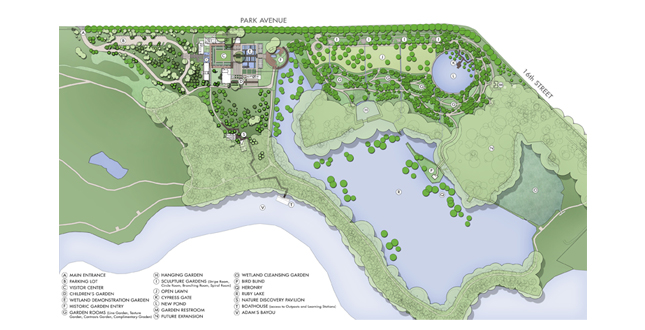 Close Me!
Close Me!Plan view of Shangri La Botanical Garden & Nature Center: site entry (A); parking (B) and Visitor Orientation Center (C) and related complex of attractions. The Visitor and Orientation Center was certified LEED Platinum for new construction.
Download Hi-Res ImageImage: Jeffrey Carbo Landscape Architects
Image 1 of 15
 Close Me!
Close Me!The Visitor and Orientation Center at Shangri La features three renovated greenhouses from Lutcher Stark’s original garden, as well as new additions including: theatre/ exhibit spaces, administrative offices, café’, bookstore, volunteer offices and restrooms. Visitors view a seven minute movie in the theatre upon arrival titled “New Horizons”, which tells the story of Lutcher Stark and the history of his gardens.
Download Hi-Res ImageImage: Chipper Hatter
Image 2 of 15
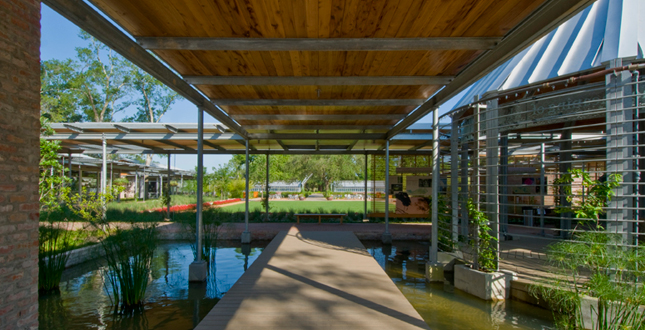 Close Me!
Close Me!Visitor Center entrance with distant view of greenhouses. Patrons enter the Orientation and Visitor Center via a boardwalk spanning pools of collected rainwater. The landscape architects choreographed visitor movement through a meditation pavilion, orientation exhibit space, wetland demonstration garden and numerous educational exhibits.
Download Hi-Res ImageImage: Hester + Hardaway
Image 3 of 15
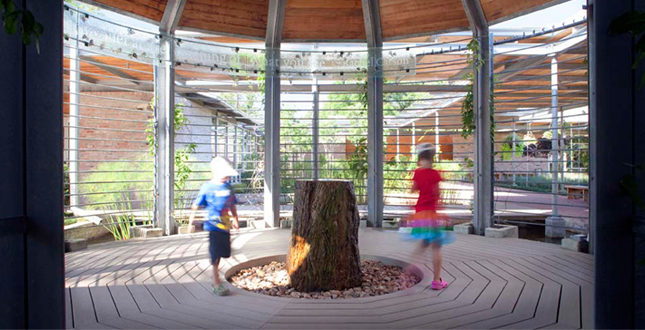 Close Me!
Close Me!Luther Stark’s petrified wood collection was used as the centerpiece of the meditation pavilion, where rain water from the pools below is recirculated from top and over the petrified log, and returned to the pools.
Download Hi-Res ImageImage: Chipper Hatter
Image 4 of 15
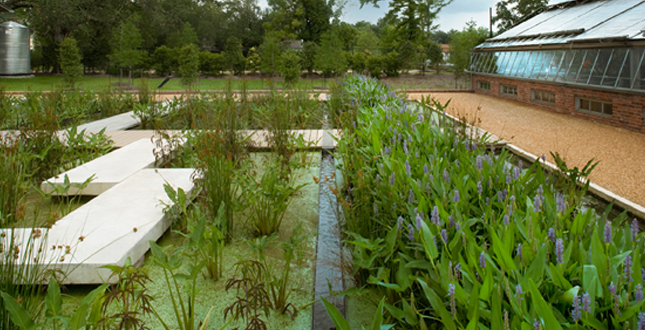 Close Me!
Close Me!A 2.5-acre Wetland Demonstration Garden (E) in the Visitor Center complex filters and cleans water pumped from the heronry area of Ruby Lake (R) within a four-day cycle. The lake had become eutrophic because of waste from thousands of seasonal migratory and nesting birds, and significant environmental remediation was required.
Download Hi-Res ImageImage: Marc Cramer
Image 5 of 15
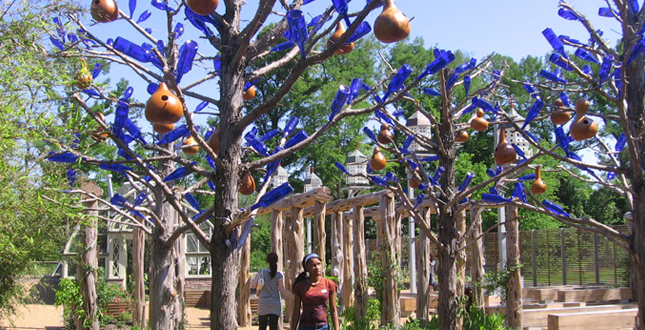 Close Me!
Close Me!The Children’s Garden is an educational venue for school groups. Bottle trees, vernacular expressions of the region, add color, cultural symbology, and folklore. These are cedar trees, victims of Hurricane Rita, and are now recycled as armatures for vines and adorned with gourds and empty blue bottles “to capture evil spirits.”
Download Hi-Res ImageImage: Chipper Hatter
Image 6 of 15
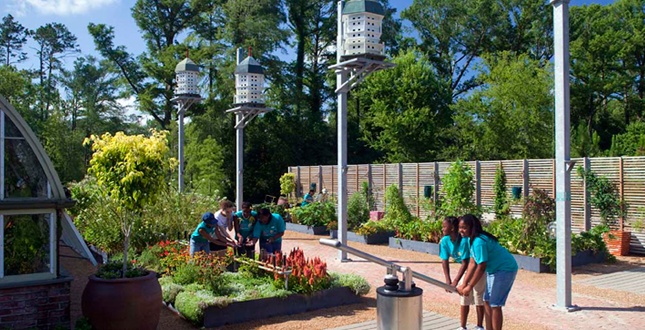 Close Me!
Close Me!The Children’s Garden (D), entered from the Visitor Center, features hands-on exhibits in plant propagation and botany. Students transplant seedlings under salvaged and restored Purple Martin houses, re-fashioned from Lutcher Stark’s original garden, as elements in this contemporary garden.
Download Hi-Res ImageImage: Chipper Hatter
Image 7 of 15
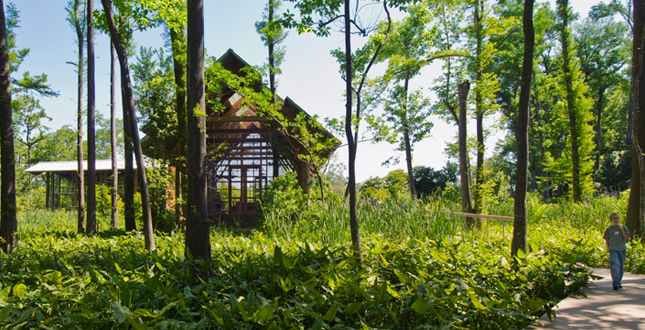 Close Me!
Close Me!Elevated boardwalks extend from the Visitor Center, Environment Education Pavilion and Science classroom (both seem in background) through wetlands vegetated with native aquatics to the boat house, where docent led boat tours travel Adam’s Bayou to the outdoor classrooms.
Download Hi-Res ImageImage: Hester + Hardaway
Image 8 of 15
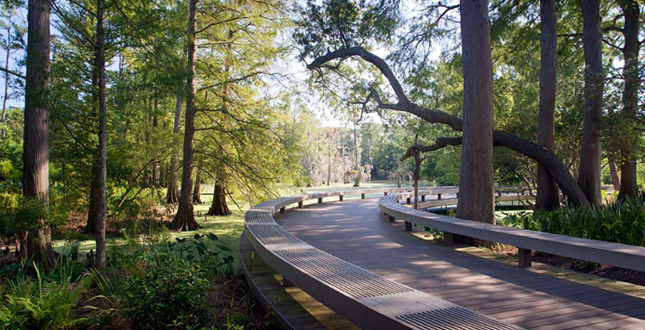 Close Me!
Close Me!Boardwalks (F) reminiscent of council rings, conceptually extend the growth rings of a centralized, tree-filled plaza. Made of recycled plastic composite decking and helical piers, these unwind into the Botanical Garden. Visitors are greeted with a quote from landscape architect Jen Jensen’s Siftings (1939): “Art has its roots in the soil…”
Download Hi-Res ImageImage: Chipper Hatter
Image 9 of 15
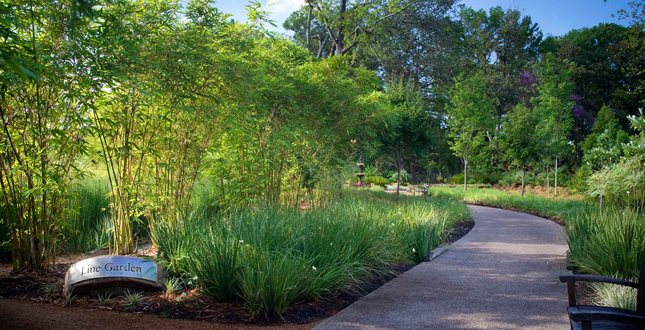 Close Me!
Close Me!The Line Garden (G) introduces visitors to one of a series of four Garden Rooms inspired by and highlighting basic elements of design composition (line, texture, and form). The landscape architects showcased shape, color, and contrast in each Garden Room through the use of pavement patterns and plant selections.
Download Hi-Res ImageImage: Chipper Hatter
Image 10 of 15
 Close Me!
Close Me!Shangri La is a migratory and nesting ground for thousands of birds including several species of herons. A bird blind (P) on Ruby Lake is a quiet spot in the garden where visitors observe the now-protected heronry, a nesting area and habitat for migratory birds. Louvered panels make viewing easy for children and adults. Openings at different levels accommodate visitors of all heights, and information about the site’s many bird species are illustrated on bench back-supports.
Download Hi-Res ImageImage: Hester + Hardaway
Image 11 of 15
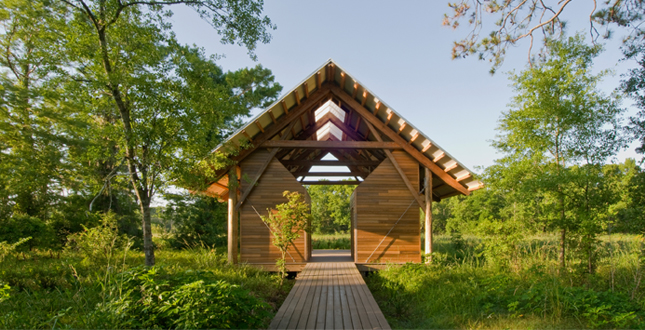 Close Me!
Close Me!The Cypress Knee Outpost is one of two solar-powered buildings offering a resting place and outdoor classroom for docent-led tours and instruction. The Cypress Knee and Beaver Pond Outposts were field-sited to maximize their proximity to three unique eco-tones, a cypress/ tupelo swamp, meadow and pine forest.
Download Hi-Res ImageImage: Hester + Hardaway
Image 12 of 15
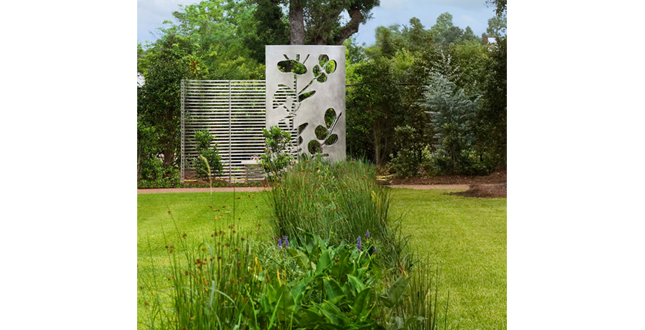 Close Me!
Close Me!Four site sculptures by Canadian environmental artist Linda Covit are installed in the Sculpture Rooms (I) These rooms celebrate Lutcher Stark’s love of art and nature by showcasing four natural botanical forms: branches, stripes, spirals, and circles. Children enhance their observation skills by looking for nearby plants with similar forms (conveniently planted nearby). A runnel originates at each Sculpture Room; water is pumped from the heronry of Ruby Lake (R) and filtered biologically through these vegetated swales before being returned to the lake.
Download Hi-Res ImageImage: Marc Cramer
Image 13 of 15
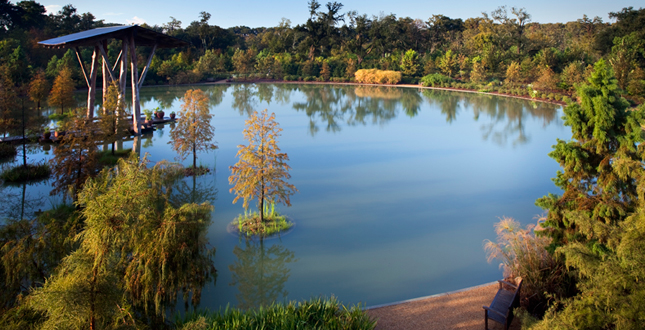 Close Me!
Close Me!The new circular pond (L) and the monumental Cypress Gate (K) refer to Asian garden influences that inspired Stark’s original garden and the torii gate, the entrance to a place “where birds reside.” The timbers for the structure were milled on site from trees felled by Hurricane Rita, near where they once stood.
Download Hi-Res ImageImage: Chipper Hatter
Image 14 of 15
 Close Me!
Close Me!An aerial view of the gardens, new pond and existing heronry lake. The new gardens were located approximately where Mr. Stark’s were originally, yet moved 400 feet from the heronry to create a native buffer, as recommended by our migratory bird specialist.
Download Hi-Res ImageImage: Louisiana Helicam
Image 15 of 15
Project Statement
Shangri La Botanical Gardens and Nature Center is the first LEED Platinum-NC project in Texas. When it opened in 2008 it was one of only 50 Platinum projects in the world. The 252-acre site, in southeast, Texas, is now a hub of environmental awareness and education about regional landscapes and animal habitats. Shangri La’s design and programming make visible the life processes of many species of wildlife within the context of a native landscape, recreated botanical gardens, and innovative center for environmental education.
Project Narrative
—2012 Professional Awards Jury
Shangri La Botanical Gardens and Nature Center is an example of responsible environmental stewardship in its mission, design, construction, operations, and maintenance. The original garden dates from the mid-twentieth century and was the vision of H. J. Lutcher Stark, a prominent Texas businessman and philanthropist who resided in Orange. Inspired by the mystical retreat represented in James Hilton’s popular 1933 novel Lost Horizon, Lutcher Stark sought to create his own haven of indescribable beauty where time would stand still, and in 1937, he began creating Shangri La. The garden he created became fully realized in the late 1940s and through the 1950s was a horticultural showplace primarily for his collection of azaleas and camellias. The garden was open to the public and became a popular regional tourist attraction. A devastating freeze in the late 1950s damaged much of the collection, and the garden closed, but remained a favorite camping area for local Boy Scouts.
In the early 2000s the Stark Foundation determined that this 252-acre site, with mixed tupelo, cypress, and pine trees, a bayou, migratory birds, gardens, and lake was a site of extraordinary ecological diversity and held great potential for redevelopment. The Board elected to renovate the gardens into a regional center for environmental awareness and education and engaged our firms to assemble a team toward that end. As prime consultants, our firms assembled a team of over forty consultants and conducted over seven years of research, conceptual and schematic design, team assembly, client interface, programming, documentation, construction supervision and observation to bring this project to reality. The team included the general contractor, architect, water quality experts, migratory bird specialists, environmental engineers, economic planner, exhibit designer, LEED consultant, wetlands expert, together with many other specialists, consultants, and professional staff.
Construction was set to begin in late summer, 2005, when hurricanes Katrina and Rita hit coastal Louisiana and Texas. The Texas-Louisiana border took a direct hit from Rita, and over 75 percent of the Shangri La’s inventory of trees was destroyed, together with pre-construction work already in progress on site. The landscape was devastated and the community demoralized. Nevertheless, the Stark Foundation’s board, sensing that environmental education was now more important than ever before, determined to move forward with this project and its goal of making this site one of the most environmentally responsible developments in America.
Shangri La is located in Orange, Texas, a small town of 18,000 residents. Lutcher Stark moved here in the 1930s, made his fortune from this region, and in 1961, established the Nelda C. and H. J. Lutcher Stark Foundation. Since its inception, it has nurtured the local economy and provided resources for the Orange community through general educational initiatives (college scholarships for local residents), cultural programming (a performing arts series), and public facilities (a house museum, an art museum, and a performing arts auditorium).
Recent efforts have focused on the region’s ecosystem via K-12 cross-programming, teacher workshops, community events, and camps. After the death of Stark’s widow in the 1990s, Shangri La re-emerged under the oversight and care of the Stark Foundation. The Foundation’s goal of re-opening the garden and grounds grew, and our firms were hired to interpret, reinstate, and direct its existing mission to “mentor children of all ages to be kind to their world”. Over time, this mission has evolved and expanded to “ignite curiosity, instill a sense of wonder, nurture creativity, spark excitement, encourage exploration, inspire respect, expand knowledge, and model stewardship.”
The landscape architects and client rigorously examined Shangri La’s three core strengths — its botanical garden, bayou, and birds — to expound on their environmental attributes, to make them visible, and to instill a sense of their importance among the public
The Visitor Center is an enclave of small buildings organized around functional landscape spaces. These buildings form an open foyer to the Botanical Garden and display extensive examples of sustainable practices: recycled asphalt paves the parking lot; pine and cypress trees felled by Hurricane Rita are used as wheel stops, benches and arbors; water collection cisterns serve the building’s grey water uses; there is a hands-on children’s garden and nature-focused educational exhibits including a 2.5-acre wetland and water cleansing exhibit. This man-made wetland features aquatic plants, small pumps, and runnels that carry, filter, and clean water from Ruby Lake over a four-day period, finally returning the cleansed water through a brick cistern and steel runnel. Shangri La’s Visitor Center and its education zones emphasize Stark’s vision of art in nature, love of plants, and environmental philanthropy.
From the Visitor Center, the public moves through the site to its three core education zones:
- Botanical Garden: Organized within a historical framework, the garden was restored through a contemporary design with added layers of visual art and emphasis on design principals. The idea of line, shape, color, texture, and contrast are expressed through plant selection, patterning, and site-specific sculptures that reinforces the landscape architect’s vision of a visual dialogue among native and adapted plant species, as well as art.
- Bayou/Nature Areas: Docent-led boat tours along Adam’s Bayou inform visitors about the site’s water ecosystem. Visitors can exit the tour at remote docks and boardwalks that lead to environmental outposts powered by solar panels. Boardwalks were first located on topographic plans then later strategically field-sited for maximum landscape sensitivity. The boardwalks use helical pier technology that minimizes ground disturbance with decking that is recycled plastic.
- Birds: Blue Herons and numerous coastal bird species migrate and nest at Shangri La’s Ruby Lake, thereby playing a major role in how the landscape architect selected construction methods and materials, programmed activities, and staged construction. A bird blind allows visitors to observe the habitats of birds and other species without disturbance. Water Demonstration Gardens at the Visitors Center and bioswales in the botanical garden naturally filter and clean water from the heronry lake that had become eutrophic from the droppings of thousands of migratory birds that nest there.
This Shangri La, like the fictional place for which it is named, is a rich and complex landscape. Despite two recent catastrophic hurricanes, the project has survived and flourished, teaching us to respect nature’s forces and admire its beauty. Shangri La has expanded environmental awareness in this region, changed the image of a small community, and inspired economic endurance through its focus on environmental responsibility and landscape stewardship.
Project Resources
Landscape Architects: Jeffrey Carbo Landscape Architects
In association with William T. Arterburn, ASLA and MESA
Shangri La Staff
Executive Director: Michael Hoke
Design & Construction Team
Architect
Lake | Flato
Fountain Consultant
Greenscape Pump Services, Inc.
General Contractor
H.C. Beck Group
Graphic Design
fd2s
Irrigation Design
Aqua Engineering
Landscape and Irrigation Contractor
Bio Landscape & Maintenance, Inc.
Owner's Representative
Boyken International, Inc. [acquired by Hill International]
Howard L. Templin, AIA and Onsite Representative: Gus Harris
Sustainable Dsign/LEED Consultant
Earthly Ideas, LLC
Featured Products
Aquatic Plants Consultant/Biological Filtration
Alan Plummer Associates, Inc.
Banding in Paving
American Marble Mosaic Company
Composite Boardwalk with HiddenFasteners
ChoiceDek
CourtyardFurniture
Gloster
Custom Stone Map
Stone Forest
Interpretive Planning and Design
Andrew Merriell & Associates
Lighting
Bega Lighting
Parking Lot Poles and Fixtures
Architectural Area Lighting
Plaza Pavers
Boral Brick
Sculpture Artist
Linda Covit
Teak Benches
Smith and Hawken
Xypex-Additive Retaining Wall Pools
Technical Coating Services Inc.






